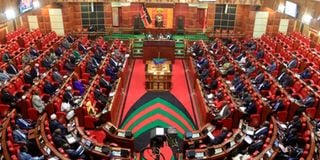Premium
Battle for numbers in the National Assembly, Senate

A joint sitting of the National Assembly and Senate on November 30, 2021.
Even before the presidential results are announced, the power see-saw that will follow the 2022 General Election was the subject of political talk, signalling a tight power balance around Kenya’s fifth president.
The control of the National Assembly, the Senate and the Council of Governors will be key to either Deputy President William Ruto or Azimio la Umoja One Kenya flagbearer Raila Odinga.
And yesterday, Mr Odinga’s running mate gave a glimpse into how Azimio views business going forward.
In her address to Azimio’s elected leaders, Ms Martha Karua spoke poetically of the fact that the coalition’s elected MPs are “just short of 180”.
Her remarks on the anticipated numbers were, however, premature as results from various constituencies continue streaming in.
“We have 24 governors at the moment. If you add Mombasa and Kakamega, whose by-election is coming later, you will see that we have strength around the country. If you look at our competition, they are just at about 130 MPs when I last counted. Even if it improves, it will not come anywhere near what we have,” said Ms Karua.
She added that the numbers are proof that they will carry the day when the presidential tally is announced: “There is no way the tally can be against us.”
With the Kenya Kwanza Alliance taking the lion’s share of the Senate and Azimio claiming the prize in the National Assembly and among governors, it will be an interesting power play for whoever wins the polls.
By Friday, Kenya Kwanza had bagged 147 members of the National Assembly while Azimio had claimed 130. However, official results for various seats continue to be released, with more expected today.
According to lawyer Nelson Havi, who came second in the race to be Westlands MP on a United Democratic Alliance (UDA) ticket, the numbers of elected leaders are proof that Kenya Kwanza (which UDA is part of) swept the presidency.
“It is an asserting confirmation that Kenya Kwanza is popular to govern at all levels. There will be no need for compromises of whatever kind,” he told the Sunday Nation.
“It means the business of government runs smoothly at all levels: National Assembly, Senate and even at the devolved governments,” he added.
Mr Havi dismissed Ms Karua’s claim of superiority, saying UDA as a party has “an almost 50 per cent majority everywhere”.
“Look at the Senate, for instance. Kenya Kwanza commands 24. The only other senator who is not from UDA is Moses Wetang’ula. Come to the National Assembly, it’s almost 50 per cent,” he said.
So, between the National Assembly, the Senate and the Council of Governors, which one holds more sway?
According to Dr Fred Ogola, a Strathmore University lecturer who participated in ODM nominations earlier in the year, controlling the National Assembly is the gold medal.
“First of all, the Council of Governors has no position in national government running. They are just a lobby group; so they don’t have any control over the national government,” he said.
“The most important is the control of the National Assembly. Once you control the National Assembly, the Senate can do whatever, because they are supposed to be adjudicating devolution matters,” added Dr Ogola.
In the Senate, Kenya Kwanza had 24 lawmakers while Azimio had 22.
“There is a blue wave in Parliament, and that will help if Raila becomes President. But if at all Ruto wins the election, the yellow wave won’t help,” said Dr Ogola.
He also reasoned that a number of MPs are likely to shift camps depending on who is declared the President. The scholar predicts that depending on the coalition that takes over the Executive, there are likely to be shifts by MPs and senators to the government side.





